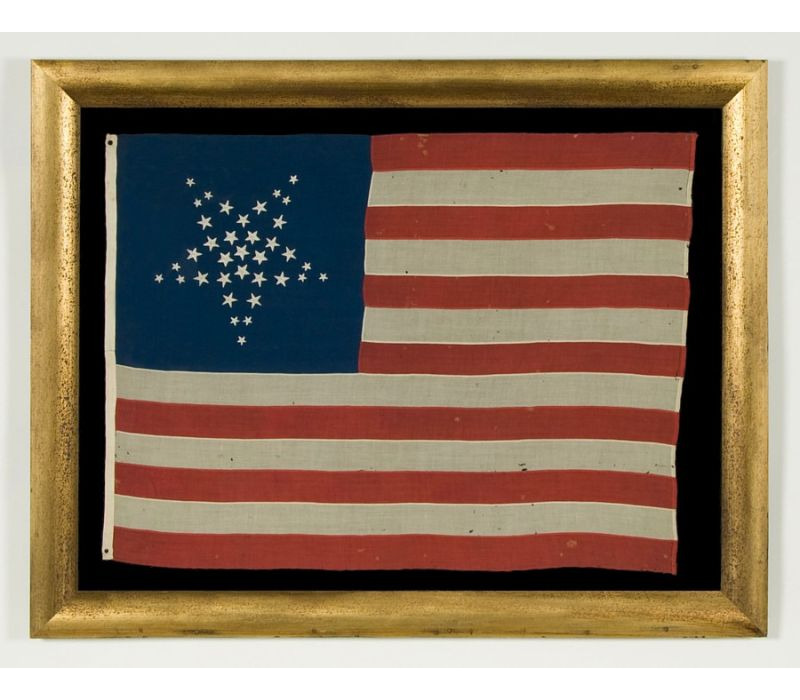
| |
36 HAND-EMBROIDERED STARS IN TWO DIFFERENT SIZES, ARRANGED IN THE FORM OF A WHIMSICAL, INVERTED GREAT STAR PATTERN, AN EXTRAORDINARY HAND-SEWN EXAMPLE IN A RARE, SMALL SIZE, CIVIL WAR PERIOD, NEVADA STATEHOOD, 1864-67 |
|
| Available: |
Sold |
| Frame Size (H x L): |
50.5" x 65.25" |
| Flag Size (H x L): |
39" x 52" |
|
| Description....: |
|
36 HAND-EMBROIDERED STARS IN TWO DIFFERENT SIZES, ARRANGED IN THE FORM OF A WHIMSICAL, INVERTED GREAT STAR PATTERN, AN EXTRAORDINARY HAND-SEWN EXAMPLE IN A RARE, SMALL SIZE, CIVIL WAR PERIOD, NEVADA STATEHOOD, 1864-67:
This exceptional Civil War era flag, with 36 stars, is extraordinary for several reasons. The foremost among these is the striking, inverted, Great Star configuration (a large star made out of smaller stars), which appears in an inverted position (with two points up) on a beautiful, royal blue canton. Among flag collectors, the Great Star configuration is considered the Rolls Royce of all 19th century geometric patterns. It probably came about shortly before 1818, when Congressman Peter Wendover of New York requested that Captain Samuel Reid, a War of 1812 Naval hero, help to create a new design that would become the third official format of the Stars & Stripes. The primary concern of ship captains was that the signal remained easily recognized on the open seas. Reid's concept of placing all the stars in a star-shaped pattern would have kept the constellation in roughly the same format as the number of states grew and more stars were added, in a distinct design that could be quickly identified through a spyglass. Though his proposal was rejected by President Monroe, due to the increased cost of arranging the stars in this manner, the Great Star was produced by anyone willing to make it. Its rarity today, along with its beauty, has driven its desirability among collectors.
Also of important note is the construction. Both the canton and the stripes are pieced of what is either fine merino wool or a wool and silk blended fabric that is entirely hand-sewn with great precision and there is a cotton hoist with two hand-sewn, whip-stitched grommets. The stars, which appear in two different sizes, are expertly hand-embroidered from white silk thread. Note how it actually appear as if there are four different sizes of stars, due to an optical illusion that is created by their particular distribution and placement. This adds a tremendous folk feature to an already fantastic design.
Yet another important factor is the small size of the flag, which is unusual for the 19th century. Today, in the 21st century, flags with pieced and sewn construction that measure five feet long or shorter are commonplace. Prior to the 1890's, however, sewn flags of this size are considered extraordinarily small. Parade flags (also called hand-wavers), were printed on cloth or paper. These generally measured three feet long or smaller and were made for short-term use at parades, reunions, and rallies. Their sewn counterparts, however, made for long-term outdoor use, were typically between seven and thirty-five feet in length, sometimes even larger. This is because the purpose of flags in the 19th century and prior was primarily as signals that needed to be seen from a distance to be effective. This changed as we moved into the 20th century. As time passed their use became more and more decorative, for the general display of patriotism. In the 19th century, even those flags made for decorative purpose were often large by today's standards, so the average 19th century sewn flag can be cumbersome to frame and display in an indoor setting. This is why many collectors prefer printed parade flags and smaller sewn flags, such as this one, the size of which is ideal for a balance of visual impact and versatility.
The small size, desirable construction and the bold design of the flag combine to place among the very best examples of the period.
The 36th state, Nevada, entered the Union during the Civil War on October 31st, 1864. The last Confederate general surrendered on May 26th, 1865. The 36 star flag became official on July 4th of that year, but makers of printed flags would have begun adding a 36th star to their flags in 1864, even before the addition of the new state occurred. Lincoln pushed Nevada through just 8 days before the November election to increase his support. While the population of the state was quite small, it was a free state and its political alignment was generally Republican. The 36 star flag was replaced by the 37 star flag in 1867, with the addition of Nebraska.
Mounting: The flag has been hand-stitched to 100% silk organza on every seam and throughout the star field. The flag was then hand-sewn to background of 100% cotton, black in color, which has been washed to remove excess dye. An acid-free agent was added to the wash to further set the dye and the fabric was heat-treated for the same purpose. The flag was then placed in a black-painted and hand-gilded, contemporary Italian molding. The front is U.V. protective acrylic.
Condition: There are only very minor holes and darning repairs. This is simply an exceptional state of preservation for a wool flag of the Civil war era with wool content and a virtual 10-out-of-10 for all practical purposes. |
|
|
|
| Collector Level: |
Flags for the truest Patriots. My best offerings |
|
| Flag Type: |
Sewn flag |
|
| Star Count: |
36 |
|
| Earliest Date of Origin: |
1864 |
|
| Latest Date of Origin: |
1867 |
|
| State/Affiliation: |
Nevada |
|
| War Association: |
1861-1865 Civil War |
|
| Price: |
SOLD |
|
| |
Views: 3592 |
|
|
|

